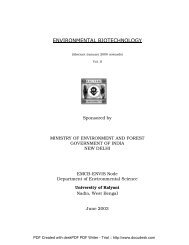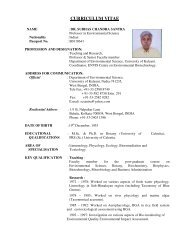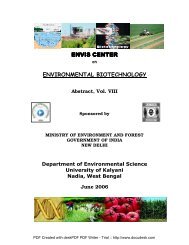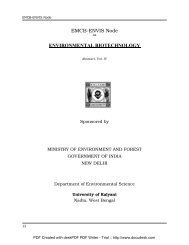EMCB-ENVIS Node ENVIRONMENTAL BIOTECHNOLOGY
EMCB-ENVIS Node ENVIRONMENTAL BIOTECHNOLOGY
EMCB-ENVIS Node ENVIRONMENTAL BIOTECHNOLOGY
You also want an ePaper? Increase the reach of your titles
YUMPU automatically turns print PDFs into web optimized ePapers that Google loves.
<strong>EMCB</strong>-<strong>ENVIS</strong> Centre<br />
the termite's own cellulases and those of its gut protists, was elucidated at the molecular level.<br />
Higher termites degrade cellulose apparently using only their own enzymes, because of the<br />
absence of symbiotic protists. Termite gut prokaryotes efficiently support lignocellulose<br />
degradation. However, culture-independent molecular studies have revealed that the majority of<br />
these gut symbionts have not yet been cultivated, and that the gut symbiotic community shows a<br />
highly structured spatial organization. In situ localization of individual populations and their<br />
functional interactions are important to understand the nature of symbioses in the gut. In contrast<br />
to cellulose, lignin degradation does not appear to be important in the gut of wood-feeding<br />
termites. Soil-feeding termites decompose humic substances in soil at least partly, but little is<br />
known about the decomposition. Fungus-growing termites are successful in the almost complete<br />
decomposition of lignocellulose in a sophisticated cooperation with basidiomycete fungi<br />
cultivated in their nest. A detailed understanding of efficient biorecycling systems, such as that<br />
for lignocellulose, and the symbioses that provide this efficiency will benefit applied<br />
microbiology and biotechnology.<br />
Biodegradation<br />
A. A. M. Langenhoff, J. J. M. Staps, C. Pijls, A. Alphenaar, G. Zwiep, H. H. M. Rijnaarts.<br />
(TNO Environmental, Energy and Process Innovation, Department of Environmental<br />
Biotechnology, Apeldoorn, The Netherlands. Tauw Milieu Consultancy, Deventer, The<br />
Netherlands. Akzo Nobel Chemicals, Hengelo, The Netherlands). Intrinsic and Stimulated<br />
In Situ Biodegradation of Hexachlorocyclohexane (HCH). Water, Air and Soil<br />
Pollution: Focus, 2(3) (2002) 171-181.<br />
The feasibility of the biodegradation of HCH and its intermediates has been investigated. A<br />
recent characterisation of two sites in The Netherlands has shown intrinsic biodegradation of<br />
HCH. At one site, breakdown products (monochlorobenzene, benzene and chlorophenol) were<br />
found in the core of the HCH-plume, whereas the HCH-concentration decreased over time and<br />
space. Characterisation of a second, industrial site indicated less intrinsic biodegradation and the<br />
need to stimulate biodegradation. In the laboratory, enhanced HCH degradation was tested with<br />
soil and groundwater material from both sites, and the required conversion to the intermediates<br />
benzene and monochlorobenzene was demonstrated. Furthermore, the biodegradation of these<br />
intermediates could be initiated by adding low amounts of oxygen (







